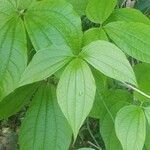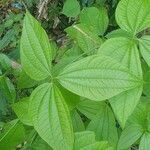Tuber in a general way globose, but lobed, occasionally slightly elongated, up to 35 kg or even more, straw-coloured to light grey outside, produced at the surface of the soil and intensely poisonous, flesh white to lemon yellow. Stem to 9 mm in diam. or more, usually prickly, green to straw-coloured, at first pubescent, then glabrescent. Bulbils never seen. Leaves 3-foliolate; petiole as a rule rather longer than the middle leaflet, to 25 cm long, frequently with small prickles on the larger nerves at the back; middle leaflet elliptic or elliptic-oblong, rarely obovate, still more rarely tri-partite, acuminate, acute at the base, to 30 by 28 cm; lateral leaflets inequilateral, the outer half 3-nerved; blade herbaceous in the Indian var. daemona (ROXB.) PRAIN & BURK. (1934), more or less chartaceous in the varieties of Malaysia particularly in D. hispida var. hispida upper surface thinly silky when young, then glabrous, with all the nerves conspicuous; lower surface retaining its hairs to some extent; petiolules to 10 mm. Male flowering axes gathered into large leafless inflorescences twice or thrice compounded, sometimes 50 cm long; axes bearing the flowers usually solitary, with upwards of 40 flowers which are closely packed in var. daemona, but spaced in the other varieties, clothed in tawny or white hairs [var. mollissima (PRAIN & BURK.) PRAIN & BURK. (1927)]. Bracts just overtopping the flowers, sub-saccate and acuminate, pubescent at the back. Outer tepals orbicular, very thin at the margin, pubescent on the back at the middle, ¾ mm diam., inner ones a little longer and firmer, incurved. Stamens all fertile, ½ mm long, anther as long as the filament. Female flowering axes solitary from upper leaf axils, downwardly directed, when capsules are mature pendulous by their weight. Flowers spaced. Bracts triangularly lanceolate, pubescent, 2-2½ mm long. Fertilized ovaries and capsules facing more or less upwards. Outer tepals ovate-lanceolate, pubescent, inner ones a trifle smaller. Capsules becoming glabrous, honey-coloured, imbricating, apex obtuse in various degrees, base variable and at times one wing may be more truncate than another (Fig. 6e); sometimes the wings are retuse at the base about the stipe; wings broadest above the middle, to 40-50 (-60) by 10-12 mm, their margin sometimes freed in dehiscence and looking like a fine wire. Seeds winged to the base of the cell.
More
Tubers brown, ovoid or irregularly shaped, variable in size, poisonous; transverse section white. Stem twining to left, to 30 cm, terete, stout, pubescent when young, glabrescent, prickly. Leaves alternate, palmately 3-foliolate; petiole to 30 cm, hairy; middle leaflet ± ovate to elliptic, 6--12(--17.5) × 4--12 cm, adaxially sparsely hispid, glabrescent, abaxially hispid, palmately veined, apex acuminate; lateral leaflets ovate-elliptic or nearly broadly oblong, oblique, smaller than middle leaflet, margin entire. Male spikes in axillary panicles to 50 cm with 2 levels of branching, most parts densely tomentose. Male flowers: in dense clusters; perianth ca. 1 mm, outer lobes smaller and thinner than inner ones; stamens 6. Female spike solitary, to 40 cm. Capsule long ellipsoid, 3.5--7 cm, leathery, densely pubescent; wings 1.2--1.5 cm wide. Seeds inserted near apex of capsule; wing pointing toward capsule base. Fl. Apr--May, fr. Jul--Sep.
A yam. A climbing vine which can be quite long. It can be 10 m long. They twine to the left. There are thorns on the stem. It has compound leaves bearing 3 very large leaflets. The leaves can be 30 cm across. The leaflets are unequal on each side. The leaves are produced one after another along the stem. The young leaf stalks, stems and leaflets are hairy. The leaf stalk is as long as the leaflets (10-15 cm). There are small prickles on the under surface of the main vein. The flowers are small, pale yellow and borne on compound flower clusters. The fruit are 5 cm across and divided into 3 lobes. The tuber is covered with root hairs. It has lobes. Tubers are often 15-25 cm across.
Econ. D. hispida owes its importance in famine to the comparative ease with which it surface-growing tubers can be gathered, and to their size which goes far towards relieving a situation of distress. After harvesting follow days of preparation during which the poisonous alkaloid, diosco-rine, must be washed out of the tissues by water. The process entails a killing of the tissues in which slicing, pounding, rasping and boiling may be used in various ways; then must follow days of soaking in water, sea water or water with salt in it being best. The final product is a starchy meal which can be made into palatable preparations and moreover will keep if dried and kept dry. The alkaloid is present in the foliage as well as in the tuber. A piece of the raw tuber of the size of an apple kills a man. A proverb of the Island of Roti runs—'he who eats boti (the local name for the tuber) must die'. Pounded tubers are used in India for poisoning bait for tigers. All mammals are susceptible and beyond all doubt the plant is very well protected in the forests. In many countries it is customary to prepare the meal, though in most of them to use it only when there is scarcity; but Hindu priestly law permitted the eating on fast days (cf. under D. pentaphylla). It would seem that D. hispida is planted in Java more than elsewhere; but it has not been demonstrated that a race less poisonous than the wild plant is employed. Malays who made palm sugar from Arenga formerly encouraged it because they employed pounded tubers as a paste to keep sterile the wounds of their tapping. This accounts for an unusual abundance about villages near Malacca; and for a like abundance which exists no longer but was observed by RIDLEY in Singapore Island (see RIDLEY J. Str. Br. R. As. Soc. 33 1900 167 ).
More
The tubers are eaten after processing by slicing, soaking in running water for 48 hours and then cooking. They are dried and cooked with rice and other dishes. CAUTION THIS YAM CAN BE VERY POISONOUS. NORMALLY SELECTED VARIETIES AND SPECIAL PROCESSES ARE NEEDED BEFORE IT IS USED.


